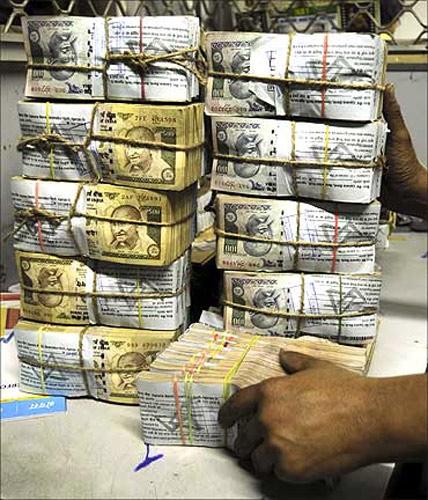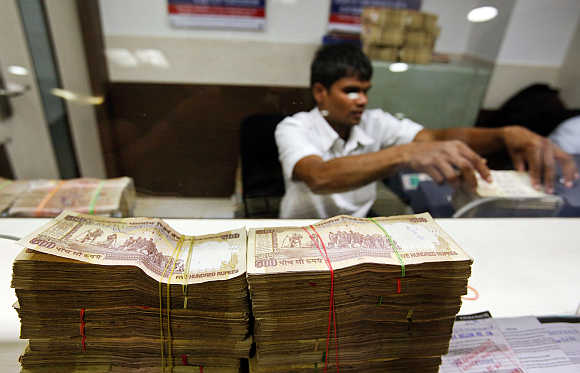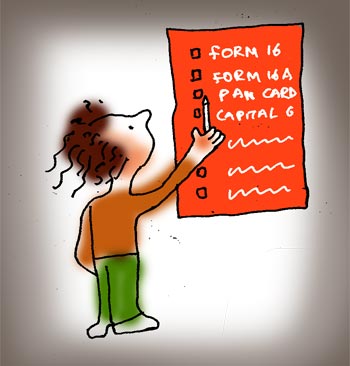 | « Back to article | Print this article |
Budget 2013 -What's in it for me?
The Finance Minister presented the Budget this year under the shadow of major challenges facing the Indian economy -- slowdown in growth, high inflationary trends, ever increasing fiscal deficit, low saving/investment and looming threat of low credit rating, to name a few.
We look at the impact of some announcements on individual tax payers:
Rajiv Gandhi Equity Scheme
With an intention to liberalise the RGESS, it is proposed to allow deduction for investments made under RGESS for a period of up to three consecutive years, instead of the initial year only.
Further, individuals having an income up to Rs 12,00,000 per annum would be eligible for deduction under RGESS.
Listed units of equity oriented funds have also been added to the eligible investment under the RGESS.
These measures would encourage channelising savings of small taxpayers into the capital markets.
Click NEXT to read further. . .
Speak to experts on Live Chat!
Union Budget, as it unfolded on February 28
Complete coverage: Union Budget 2013-14
Budget Impact Live!
Budget 2013 -What's in it for me?
Interest on housing loan
Currently, the deduction available towards interest on loan for a self-occupied house is only Rs 150,000 per annum.
The FM has, albeit for one year only, allowed an additional deduction of up to Rs 100,000 for interest payable to a specified financial institution.
The loan should be sanctioned in FY 2013-14 and should be up to Rs 25 lakh (Rs 2.5 million).
Also, the property value should be up to Rs 40 lakh (Rs 4 million) and the individual must not own another residential house on the sanction date.
Unused deduction of interest in FY 2013-14 can be claimed in FY 2014-15.
Based on the income of the individual, this would result in additional tax savings ranging from Rs 10,300 to Rs 30,900 per annum.
This would boost the real estate and allied sectors.
Click NEXT to read further. . .
Speak to experts on Live Chat!
Union Budget, as it unfolded on February 28
Complete coverage: Union Budget 2013-14
Budget Impact Live!
Budget 2013 -What's in it for me?
Tax rates
With the focus on a stable tax regime, no change has been proposed in tax slabs or rates. However, a small relief in the form of a tax rebate up to Rs 2,000 per annum, has been provided to resident income-earners with income up to Rs 500,000 per annum.
As indicated by the FM, this should generate tax savings of aggregate Rs 3,600 crore (Rs 36 billion) approximately to 1.8 crore (18 million) tax payers.
Taxes for the high income earners
As a measure to garner more revenue, a surcharge of 10 per cent on tax has been introduced for individuals whose total income exceeds Rs 1 crore (Rs 10 million), though only for FY 2013-14.
Click NEXT to read further. . .
Speak to experts on Live Chat!
Union Budget, as it unfolded on February 28
Complete coverage: Union Budget 2013-14
Budget Impact Live!
Budget 2013 -What's in it for me?
While as per the FM this would impact only the 42,800 who have declared income above the said limit, even expatriate employees working in India may be impacted on account of this surcharge.
In cases where such expatriates have agreed on net of tax packages and, hence, tax is paid by the employer on a grossed up basis, the surcharge could increase the salary cost substantially.
On the indirect tax side as well the high income earners may be impacted by the proposed enhancement of customs duty on certain imported luxury goods such as high-end motor vehicles, bikes, yachts and so on.
Click NEXT to read further. . .
Speak to experts on Live Chat!
Union Budget, as it unfolded on February 28
Complete coverage: Union Budget 2013-14
Budget Impact Live!
Budget 2013 -What's in it for me?
Insurance
It has been indicated that more health schemes will be notified to widen the scope of deduction towards health insurance premium under the overall limit of Rs 15,000 per annum.
Deduction towards premium paid on life insurance policies, for persons with prescribed disability or specified disease is proposed to be increased to 15 per cent of capital sum assured from 10 per cent (within the overall limit of Rs 100,000 per annum), for policies issued on or after 1 April 2013.
Maturity proceeds of such policies are also proposed to be exempt.
Most of the Keyman insurance policies were assigned to the keyman before maturity as life insurance policy and accordingly the tax exemptions were being claimed on maturity.
The maturity proceeds would now be taxable.
Click NEXT to read further. . .
Speak to experts on Live Chat!
Union Budget, as it unfolded on February 28
Complete coverage: Union Budget 2013-14
Budget Impact Live!
Budget 2013 -What's in it for me?
Transfer of immovable property
With a view to improving tax reporting in property transactions, it has been proposed that the buyer of an immovable property (not being agricultural land) will now have to deduct tax at source at the rate of 1 per cent on the sale price, provided the value of property is Rs 50 lakh (Rs 5 million) or more.
In cases where such capital gains are exempt for the seller, this may lead to a refund situation for him which can only be claimed by him at the time of filing his personal tax return.
Also, the buyer who was otherwise not required to deduct tax on any other payments will have to comply with procedural requirements of obtaining a Tax Deduction Account Number, filing of returns, and so on.
Any transfer of an immovable property for inadequate consideration (as compared to the stamp duty value), where such inadequacy is more than Rs 50,000, will also now attract tax in the hands of the buyer.
Click NEXT to read further. . .
Speak to experts on Live Chat!
Union Budget, as it unfolded on February 28
Complete coverage: Union Budget 2013-14
Budget Impact Live!
Budget 2013 -- What's in it for me?
Also, effective service tax rate has been proposed on residential units above 2,000 square feet or where amount charged from buyer towards property exceeds Rs 1 crore (Rs 10 million).
This would increase the cost of acquisition.
Other taxes impacting individuals Surcharge on Dividend Distribution Tax for domestic companies has been increased to 10 per cent from five per cent, only for FY 2013-14.
The rate of DDT on all non-equity funds for distributions to an individual or HUF has been increased to 25 per cent to 12.5 per cent.
This could shift the investment focus from dividend funds to growth funds (where the gains are capitalised) and also mobilise savings into bank deposits.
The FM has proposed to reduce securities transaction tax for securities such as equity futures, mutual funds and so on.
At the same time, a new Commodities Transaction Tax has also been introduced on non- agricultural commodity derivatives traded in recognised associations.
Click NEXT to read further. . .
Speak to experts on Live Chat!
Union Budget, as it unfolded on February 28
Complete coverage: Union Budget 2013-14
Budget Impact Live!
Budget 2013 -What's in it for me?
E-filing
It has been proposed to move toward the e-filing for wealth tax returns as well, which is welcome step towards technological integration.
To summarise, for an average Indian household, the impact of the Budget is fairly neutral.
It remains to see how many of these proposals actually convert into legislation and, thereafter, achieve their desired objective of enhancing growth through inclusive development.
The writer is partner, tax, KPMG








